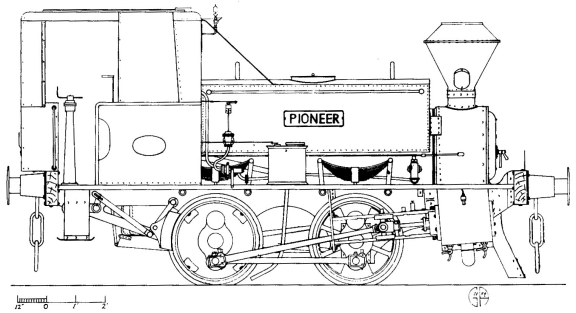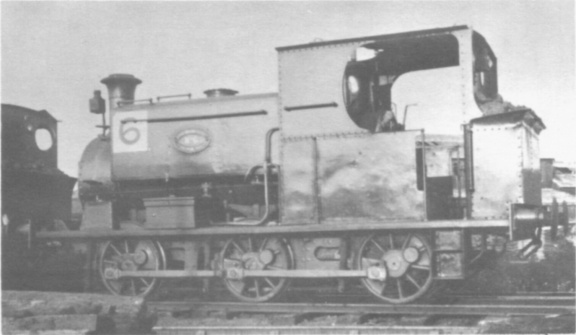
| THE INDUSTRIAL RAILWAY RECORD |
© JUNE 1967 |
TWO OLD HUNSLETS
G. ALLIEZ
(Photograph by the Author)

PIONEER
In 1942 Edward Lloyd Ltd., the papermakers of Sittingbourne, obtained a small second hand standard gauge locomotive from Smith, Patterson & Co. Ltd., Pioneer Foundry, Blaydon. It had been named PIONEER and this name was retained at Sittingbourne. Rebuilt by Hudswell Clarke in 1906 it had acquired a cab and injector fittings of their design, and Lloyd's equipped it with a balloon type spark arrester chimney which spoilt the general appearance.
I first saw this engine in 1947 and after it had been pulled into the open for photographs we took the opportunity of examining it in detail to discover its identity. Several details, particularly the shape of the saddletank suggested Hunslet as the builder. Examination underneath revealed a very early design for disposing of the cylinder exhaust; a horizontal pipe from each cylinder joined the blast pipe in the form of an inverted "T" and these elbow joints must have caused considerable back pressure. This early pattern for the exhaust indicated a date of building prior to 1870. A careful scrutiny of all parts followed and this was rewarded by finding the number "18".
A letter was sent to Hunslet (their records not being available at that time) enquiring of the possibility that PIONEER was their No.18. Their reply was in the negative as No.18 was an 0−6−0 saddletank. Undaunted, Hudswell Clarke were then approached for any details of an 0−4−0 saddletank rebuilt by them in 1906. They were most helpful and identified the engine concerned as Hunslet No.18, received in part exchange for Hudswell Clarke 729 of 1905 supplied to Rowland C.A. Palmer-Morewood of Swanwick Collieries. After rebuilding No.18 was sold to the Schoen Steel Wheel Co. Ltd., Newlay, Leeds. (This may well have become SCHOEN No.1: a locomotive with this name was repaired in November 1917 by Hunslet but details of its identity are not stated. SCHOEN No.1 was still at Newlay in March 1918. - Hon. Eds.) The Schoen company appears to have closed down about 1919 and the movement of No.18 between then and its arrival at the Pioneer Foundry, Blaydon, have yet to be discovered.
When the Hunslet records became available it was heartening to find that No.18 of 1867 was indeed a small 0−4−0 saddletank acquired by the Swanwick Collieries, Derbyshire, in 1905.

SAMUEL WILLIAMS No.6
An engine which has always puzzled the industrial historian was Samuel Williams No.6, an 0−6−0 saddletank obviously built by Hunslet and, despite its general appearance, of considerable age. It has been recorded as Hunslet 401, but this is not correct as 401 was a 15in side tank which became Samuel Williams No.7. Along with No.6 it was obtained by Samuel Williams & Sons Ltd., Dagenham Dock, in 1909, from Sir John Jackson's plant depot at Grays in Essex. No.401 was later sold to Thos. W. Ward Ltd., and finally found its way to the War Department camp at Barnstone, Notts. In my younger days No.6 was often examined for a works number stamped on the motion, but apart from a few very high numbers nothing reasonable was ever found. In the light of recent investigation it could well be that this locomotive was none other than Hunslet No.1. I may have found the number 1 on the motion and ignored it!
My photograph of No.6 shows her appearance during service with Samuel Williams and comparison should be made with the official photograph reproduced on page 17 of RECORD 1. Reference is made on that page to the combined leading sandbox and splasher fitted about 1889 and this is plainly visible in the picture of No.6. Other similarities of special significance are the cab side sheets in two portions, and the shape of the saddletank together with the extra handrails on the top. In both, the cut out portions of the frames are parallel to the angle of the motion plate and not vertical.
As this engine was at New Sharlston Colliery, Yorkshire, I wrote to the Hunslet Engine Co. Ltd. in March 1965, suggesting that a visit to the colliery and a comparison of the engine with the original drawing of Hunslet No.1 might prove the case one way or the other. Messrs. Hunslet made an immediate visit to the colliery only to find that the engine had been cut up on site and all parts removed some four months previously. The colliery fitter said he had overhauled No.6 when it arrived (from Thornhill?) in 1950, and subsequently only twice had he taken up the coupling rod brasses. A new saddletank was supplied by Hunslet in 1960. It had proved a very economical locomotive and apart from requiring new tyres was in quite good condition when withdrawn and scrapped. Only Nos.2 and 21 were built to the same drawings as No.1.
It may be pertinent at this stage to place on record what little is known of the earlier history of No.1. Built in 1865 for Brassey & Ballard as LINDEN for use in the construction of the Midland Railway main line south of Bedford, it is later believed to have been used by Baker & Firbank on a railway contract at Dewsbury in 1873. The next owner appears to have been J.P. Edwards, the contractor, who may well have used it on the Nottingham Low Level Railway of the Great Northern Railway. For this contract it might have been named NOTTINGHAM although, according to Hunslet, this name does not appear in their records until 1902. In 1888 (again from records after provision of a new boiler she was re−named PATRICROFT and sold to T.A. Walker for use on the Manchester Ship Canal contract. However, T.A. Walker already had a locomotive PATRICROFT (Vulcan Foundry 1232 of 1888 and it is unlikely he would have two of the same name.* Contemporary records of the M.S.C. contract include a Hunslet 0−6−0 saddletank with 15in by 20in cylinders, rebuilt in 1888, and named NOTTINGHAM. This could well be Hunslet No.1, if T.A. Walker had decided she should revert to her earlier name NOTTINGHAM upon the arrival of the new PATRICROFT from Vulcan Foundry. John Jackson became a sub contractor of the Manchester Ship Canal Company in 1892 and obviously acquired this locomotive from the Executors of T.A. Walker. Later, she was most likely used on the Devonport Dockyard Extension of Sir John Jackson Ltd. It was in 1902, under the same ownership, that Hunslet records show the name as NOTTINGHAM, tending to confirm my earlier hypothesis. This is where the official records cease. Old employees of Samuel Williams maintained that, before arrival at Jackson's depot at Grays, No.6 was named SWANSEA and was at work in South Wales; prior to that she had worked at Southsea or Southampton.
* Hunslet records specifically mention the change of name to PATRICROFT in the "Engine Book" as well as on the three drawings, dated September 1878, made at the time of reboilering which are endorsed, "Engine LINDEN, renamed PATRICROFT".- Hon. Eds.